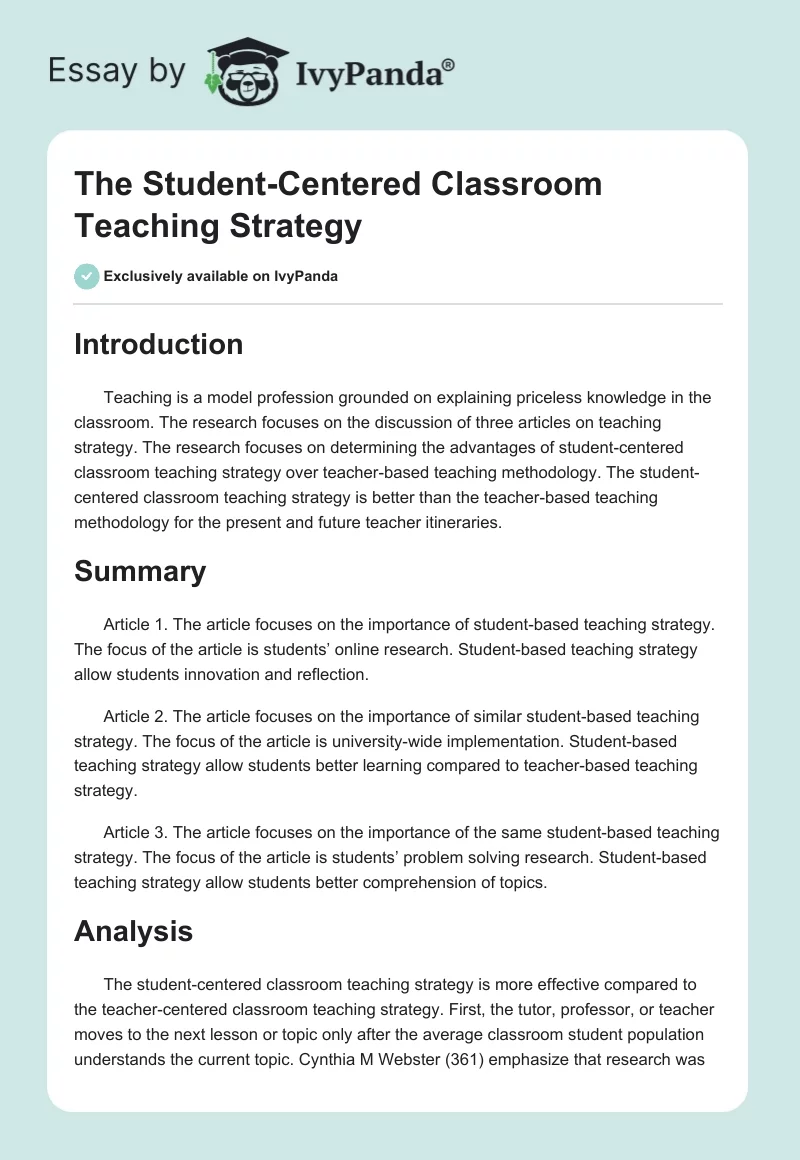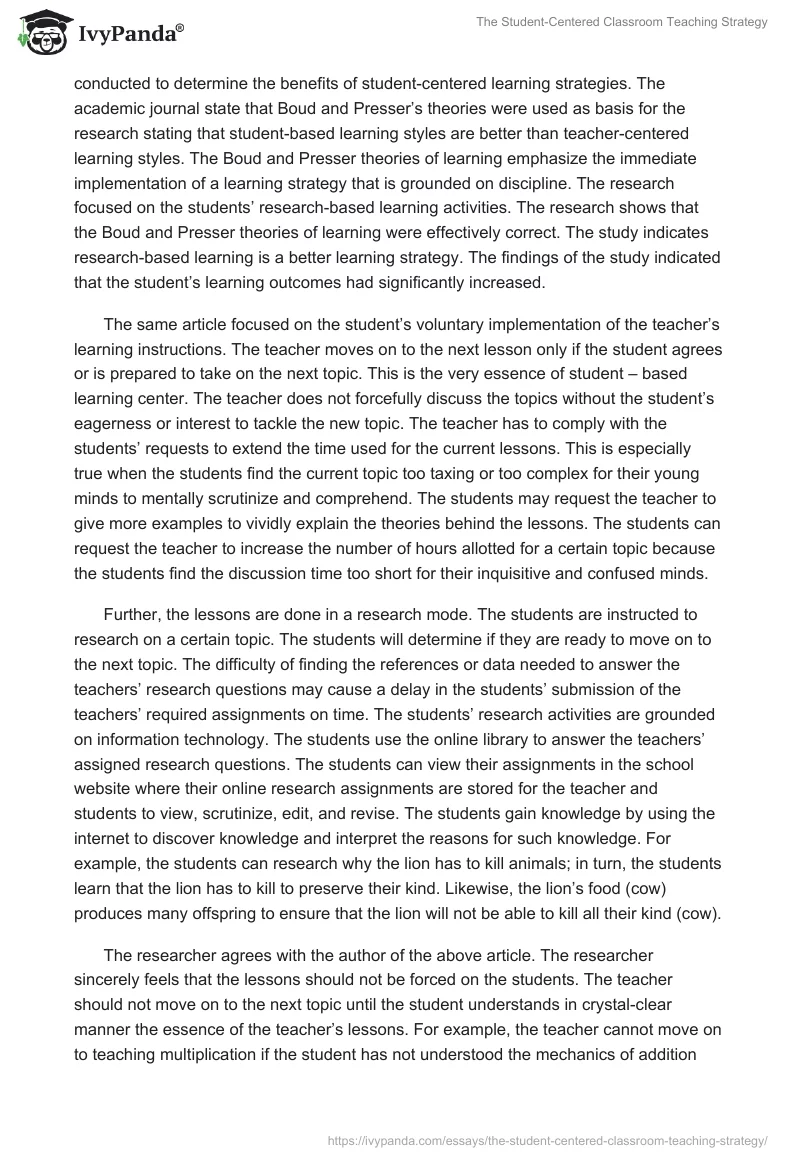Introduction
Teaching is a model profession grounded on explaining priceless knowledge in the classroom. The research focuses on the discussion of three articles on teaching strategy. The research focuses on determining the advantages of student-centered classroom teaching strategy over teacher-based teaching methodology. The student-centered classroom teaching strategy is better than the teacher-based teaching methodology for the present and future teacher itineraries.
Summary
Article 1. The article focuses on the importance of student-based teaching strategy. The focus of the article is students’ online research. Student-based teaching strategy allow students innovation and reflection.
Article 2. The article focuses on the importance of similar student-based teaching strategy. The focus of the article is university-wide implementation. Student-based teaching strategy allow students better learning compared to teacher-based teaching strategy.
Article 3. The article focuses on the importance of the same student-based teaching strategy. The focus of the article is students’ problem solving research. Student-based teaching strategy allow students better comprehension of topics.
Analysis
The student-centered classroom teaching strategy is more effective compared to the teacher-centered classroom teaching strategy. First, the tutor, professor, or teacher moves to the next lesson or topic only after the average classroom student population understands the current topic. Cynthia M Webster (361) emphasize that research was conducted to determine the benefits of student-centered learning strategies. The academic journal state that Boud and Presser’s theories were used as basis for the research stating that student-based learning styles are better than teacher-centered learning styles. The Boud and Presser theories of learning emphasize the immediate implementation of a learning strategy that is grounded on discipline. The research focused on the students’ research-based learning activities. The research shows that the Boud and Presser theories of learning were effectively correct. The study indicates research-based learning is a better learning strategy. The findings of the study indicated that the student’s learning outcomes had significantly increased.
The same article focused on the student’s voluntary implementation of the teacher’s learning instructions. The teacher moves on to the next lesson only if the student agrees or is prepared to take on the next topic. This is the very essence of student – based learning center. The teacher does not forcefully discuss the topics without the student’s eagerness or interest to tackle the new topic. The teacher has to comply with the students’ requests to extend the time used for the current lessons. This is especially true when the students find the current topic too taxing or too complex for their young minds to mentally scrutinize and comprehend. The students may request the teacher to give more examples to vividly explain the theories behind the lessons. The students can request the teacher to increase the number of hours allotted for a certain topic because the students find the discussion time too short for their inquisitive and confused minds.
Further, the lessons are done in a research mode. The students are instructed to research on a certain topic. The students will determine if they are ready to move on to the next topic. The difficulty of finding the references or data needed to answer the teachers’ research questions may cause a delay in the students’ submission of the teachers’ required assignments on time. The students’ research activities are grounded on information technology. The students use the online library to answer the teachers’ assigned research questions. The students can view their assignments in the school website where their online research assignments are stored for the teacher and students to view, scrutinize, edit, and revise. The students gain knowledge by using the internet to discover knowledge and interpret the reasons for such knowledge. For example, the students can research why the lion has to kill animals; in turn, the students learn that the lion has to kill to preserve their kind. Likewise, the lion’s food (cow) produces many offspring to ensure that the lion will not be able to kill all their kind (cow).
The researcher agrees with the author of the above article. The researcher sincerely feels that the lessons should not be forced on the students. The teacher should not move on to the next topic until the student understands in crystal-clear manner the essence of the teacher’s lessons. For example, the teacher cannot move on to teaching multiplication if the student has not understood the mechanics of addition numbers. Likewise, the teacher should not move on to the next topic, division, if the students are confused in terms of subtracting numbers. The teacher would be short-changing the students if the teacher leaves the current topic and leave the students on their own because the students paid the teachers to teach them. In addition, the above article will impress on the minds of the traditional teacher that change should be implemented; the change is the shift to the student-based teaching methodology. Further, the article vividly shows that student-based teaching methodology aptly fills the students’ inquisitive young minds’ quest for answers to many of life’s questions. The lion and cow story is a very interesting story that can better be understood using the student-based teaching methodology compared to the traditional and outmoded teacher-based teaching style.
Second, David Kember (1) proposed student-centered learning must be implemented within the Academic field. The student-centered learning should be imposed in all classrooms in the elementary curriculum. The student-centered teaching strategy should be implemented in all classrooms in the elementary curriculum. The student-centered teaching methodology should be imposed in all classrooms in the elementary curriculum. The research focused on explaining to the teacher-based instructors the importance of implementing the student-based teaching methodology during the next classroom activities. The teachers attended the seminars where good examples of student-based teaching were discussed. The seminars showed the many advantages of shifting from the teacher-based teaching methodology to the student-based teaching methodology. During the same seminars, the teachers were trained on the intricacies of determining when to move on to the next topic when the teacher-based. In addition, the teachers were given grants and scholarships for them to hone their new student-based teaching methodology. Further, the teachers were required to take a diagnostic evaluation to determine if the teachers can implement the student-based teaching methodology smoothly and without any significant difficulty on the part of the teachers. The results of the study showed that there was an increase in the learning speed of the students being taught using the new student-based teaching methodology. The study was conducted over two years. The results of the research indicated that the teachers’ quality teaching output had significantly increased. Likewise, the students’ learning ability had also increased by unprecedented levels. The effectiveness and success of the shift from the teacher-based to the student-based teaching methodology had been grounded on advisers and tutors who aided the teachers in every step of the transition to the student-based teaching methodology.
Likewise, the researcher agrees with the author of the second article. The researcher sincerely feels that the above article clearly shows that the classroom lessons should not be taught to the students in hasty fashion. The teacher should not take up the next lesson until the student comprehends the essence of the teacher’s current topic. The article gives importance to the theory that haste makes waste. The unprepared mind will surely be more confused when a complex topic is hurriedly discussed to meet the teacher-based lesson schedule.
Third, Chow J. Chung (157) theorized the student-based teaching methodology as a possible improvement of the current teaching methodology. The current teaching methodology is grounded on the teachers’ preference. Under the current teaching strategy, the teacher would choose which topic to discuss and when each topic will end. The teacher moves on to the next topic without taking into consideration whether the average student population understood the prior day’s lessons.
Under the current research, the students were given problems or cases to resolve. The students can only move on to problem if they are ready to tackle the next topic. The students are required to prove, through classroom tests and oral discussions, if they understand and come up with the required solution to the teachers’ assigned tasks, and problems. The student-based teaching methodology is named Subject –Planning Team or SPT. The team approach is geared towards monitoring the students’ progress. The teacher uses the students’ current progress as a yardstick for proceeding to a brand new topic or lesson. The student-based teaching methodology is grounded on discussing topics that the students need for their current situation. In addition, the student-based teaching methodology focuses on supplying the students with academic knowledge that will be useful after they leave the four solid walls of the classroom.
The new student-based teaching methodology incorporates all remedies that would make the students’ learning activity more enjoyable and less stressful.
As a result, the research indicated that the students’ eagerness to learn the current lessons had significantly increased. The students were excited to discover new knowledge under the student-based teaching methodology. The students were interested to comprehend why an object functions; the students are eager to know why a metal plane flies. The students were also more experimental and inquisitive when each topic was discussed. In terms of quality, the students learned to appreciate the student-based teaching methodology over their prior classroom learning experiences where the lessons were forced by the teachers on the unprepared, confused, and disgruntled students. The research findings indicated that the new student-based teaching methodology was more appropriate. Under the student-based teaching methodology, the lessons or discussions were matched to the average students’ learning capacity. Under the new strategy, the teacher was trained to tailor each lesson to the learning capacity of each student. Under the new teaching strategy, the teacher uses lesser hours discussing a simple topic because the students can easily absorb the essence or gist of the topic discussed. On the other hand, the teacher uses more hours on a topic that is too complex for the average mind to understand. The article puts importance on the role of the student as a yardstick in terms of selecting the appropriate teaching strategy.
Similarly, the researcher agrees with the author of the third article. The researcher understands the above article vividly indicates that classroom discussions must be structured to meet the hectic learning requirements of the students. The teacher should not proceed to a new topic or lesson until the student has adequate knowledge of the current topic being presented by the teacher, professor, or tutor. The third article also puts priority on the theory that haste makes waste. The young confused mind will be more puzzled when the teacher hastily opens and closes a complex topic to comply with the teacher-based discussion period.
Conclusion
Based on the above discussion, teaching is one of the noblest professions for it is based on explaining priceless knowledge in the academe. The three articles focus on the advantages of student-grounded teaching strategy. The research focuses on the preference for student-centered classroom teaching strategy over the traditional teacher-based teaching model. Indeed, the student-centered classroom teaching strategy is vividly better than the traditional teacher-based teaching methodology for the current and future teaching responsibilities; the change to the student-based learning systems should be implemented immediately.
Works Cited
Chung, Chow J. “Promoting Student Learning Through a Student-Centered Problem-based Learning subject Curriculum.” Innovations in Education and Teaching International 41.2 (2004): 157-168. Print.
Kember, David. “Promoting Student-Centered Forms of Learning Across an Entire University.” Higher Education 58.1 (2009): 1-13. Print.
Webster, Cynthia M. “Embedding Research Activities to Enhance Student Learning.”The International Journal of Educational Management 25.4 (2011): 361-377. Print.


